Growing capsicum In Containers:
The following content is all about Growing Capsicum In Containers/Pots.
Introduction for Growing capsicum In Containers
Capsicum is also known as bell peppers, capsicum is cultivated worldwide it is a key element in many cuisines. Capsicum has many names depending on the place and type. The spicy varieties are called chili peppers. Large mild varieties are called red bell pepper, green bell pepper, yellow bell peppers in the USA, United Kingdom. In New Zealand, Australia, South Africa, Singapore, and India it is called capsicum. It is also called paprika in some countries. Capsicum is native to Mexico and North America. China is the largest producer of capsicum. The taste of capsicum depends upon the growing conditions.
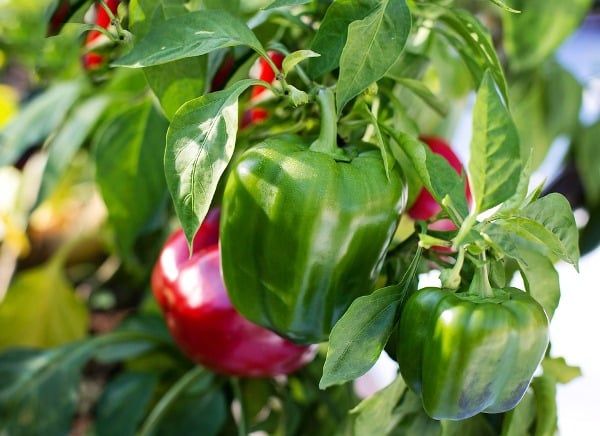
Capsicum can be successfully grown in containers, indoors, outdoors, and in backyards. Capsicum grows well in sunny locations in warm loamy soils. The ideal temperature for growing capsicum is 21 to 20 °C. Capsicum is highly nutritious with vitamins C, B6, and dietary fiber. Growing capsicum in the container could be a great idea if you are living in warm regions. Capsicum plants can tolerate under 12 °C and sensitive to frost. Capsicum grown in containers will produce more fruits than then plant grown on the ground. Extremely high temperatures of 33 to 38 °C can cause loss of pollen.
- Scientific Name for capsicum: Capsicum annum.
- Common Name: Capsicum, bell peppers.
- Family: Capsicum belongs to a family of Solanales.
Varieties of Capsicum for Growing Capsicum in Containers
- Capsicum is a single species vegetable, capsicum comes in many attractive colors like green, yellow, red, purple, and black.
- More rarely brown, white, lavender, and black are grown.
- Unripe capsicum is in green color or, less commonly, in pale yellow or purple.
- Red capsicum is ripened green bell peppers.
- Green peppers are less sweet and slightly more bitter than yellow or orange capsicum with red and red capsicum are the sweetest ones.
- Some varieties of capsicum that are suitable for container growing to choose the best one as per your climate and requirement.
- Roberta: A compact variety capsicum plant, the best choice for growing in containers. These varieties of capsicums can be grown fast and have thick juicy flesh.
- Gpsy: Early season variety with a sweet flavor. This variety can be grown outdoor and indoors.
- Orange bell: High-yielding variety, with a very sweet flavor. When the fruit ripens, it changes to orange color.
- Gourmet: A compact variety plant, gives very high yields. This capsicum turns an orange color when ripens.
- Kaibi Round: this capsicum variety has thick, crunchy flesh with round red fruits. this capsicum has very good taste.
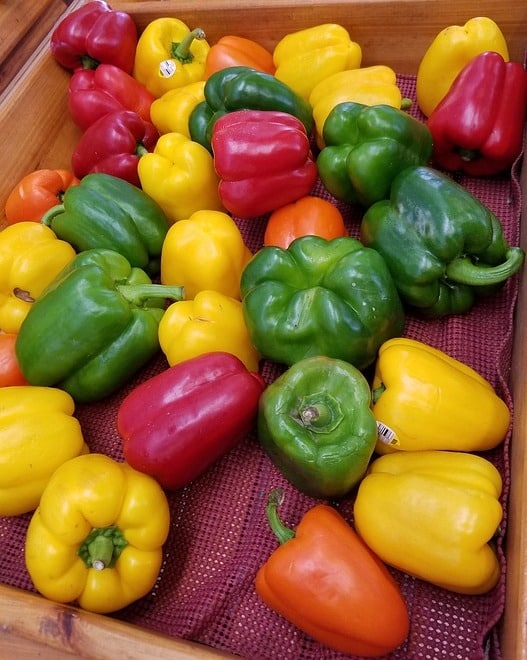
Now let us talk about Growing Capsicum In Containers
Growing capsicum in containers is quite easy. Capsicum can be propagated from seeds or you can buy a plant from the nurseries.
Choose the Best Container for Growing Capsicum In Containers
- The containers made of ceramic, clay, wood, metal, or terra cotta materials will work fine for growing capsicum.
- Don’t choose a clay container, if you are growing in sunny places. Clay pots observe more water and make the soil dry quickly.
- The containers for growing medium to large-sized capsicum should be 16-16 inches deeps and wide.
- For growing small-sized capsicum, the container size should be 12-12 inches deep and wide.
- The container should have a good draining system, at least 4 holes per container.
- Before planting, wash the container with soap and clean water, and dry it completely.
- Two plants can be grown comfortably in one container.
- Avoid using dark-colored containers, if our growing capsicum in tropical regions.
- Cover the bottom of the containers with coffee filters or fine mesh to control the dripping of soil and water.
- Place a layer of small stones under the container to control the dripping of soil and the waterlogged situation.
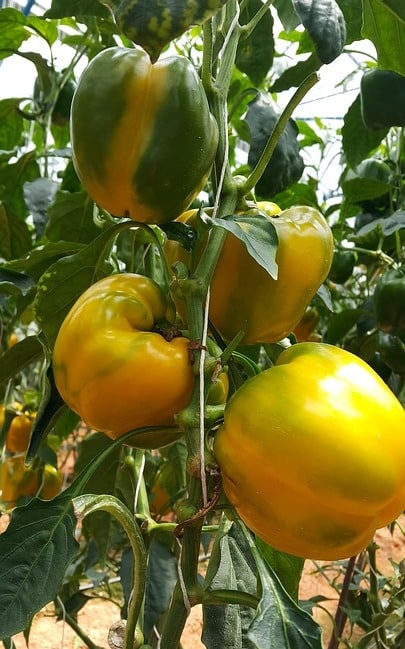
Choose the soil for Growing Capsicum In Containers
- Good quality commercial potting mix with rich organic matter is recommended for growing capsicum in containers.
- The potting mix should be well-drained, loose, and fertile.
- The pH level of the potting mix should be 5.5 to 6.8.
- Mix the potting soil with peat moss/coco peat and vermiculite or perlite (or sand).
- Adding neem cake during the planting will protect plants from soil-borne diseases and pests.
- you can prepare your own potting soil by adding peat moss, vermiculite or sand, organic manure, and 5mg of neem cake.
- Potting soil temperature should be 18 °C or above.
The Best Season for Growing Capsicum in Containers
- Capsicum is a warm-weather crop, late winter, spring, and summer are the best season to plant them in containers/indoors/backyards.
- The best season to grow capsicum in the container is February to March.
- If you are growing in greenhouses, plant them from April to May.
Propagation for Growing Capsicum in Containers
- Capsicum can be propagated from both nursery plants or from seeds. Buy good quality seeds from nurseries.
- If you are planning to grow from seeds, first buy a seed starting mix and small pots or seedling trays.
- You can get seedlings from the nursery and start growing the plants.
Steps for Growing Capsicum In Containers from Seeds
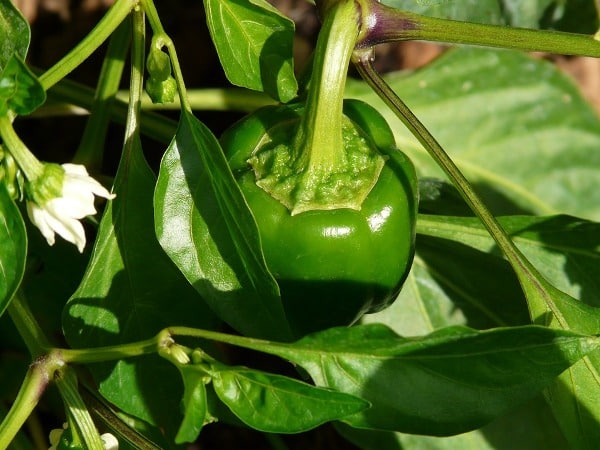
- Fill the small pots or seedling tray with seedling mix and plant two seeds 2-3 cm deep in each pot. Cover the seeds with soil slightly and damp the soil no wet.
- Soil and air temperature should be 20 to 25 °C for best results.
- Keep the tray in a warm, dry, and humid area for fast germination.
- Seeds sown in the tray don’t need direct sunlight for 1-2 weeks.
- Water the plants and cover the tray with plastic wrap to keep the soil moist.
- Capsicum seeds take 10-15 days to germinate.
- The germination period depends upon the climatic conditions.
- Once the seedlings appear, remove the plastic wrap and move the tray to a sunny area.
- During germinating, you should keep the soil or compost moist all the time, but not wet.
- Don’t make the soil dry, dryness of the soil will reduce the chances of seed germination.
- After germinating thin out the weak plant and keep the healthy plant.
- Once the seedling has true leaves, the seedlings are ready to transplant in large containers.
Transplantation method for Growing Capsicum In Containers
- Fill the container with potting soil, leaving a 1-inch distance between the soil surface and rim of the containers.
- Make sure that the soil temperature should be around 20 °C to transplant.
- If the potting soil is too cool, the plant will not grow, and flowers may drop off without producing fruit.
- Remove the seedling or nursery plants from their containers without damaging the roots.
- Dig 2-inch holes in the middle of the container and plant the young plants.
- Cover the roots with potting mix loosely.
- Now transplant them into the desired containers, and water the plant.
- Using water can with a fine rose, water the young plant without harming the roots.
- Feed the plant with 15-15-15 ratio balanced liquid fertilizer after planting.
When and how to Water for Growing Capsicum In Containers
- Capsicum grows well when the soil is moist all the time.
- Do not overwater or underwater the plant.
- A strict water schedule should be provided for young plants till the roots get hard.
- In summer seasons or dry weather, water the plants once a day as per the requirement.
- Apply water only to the soil around the base of the plant.
- Overhead watering may rinse pollen and reduce the fruit. Making foliage moist will increase the chance of fungal diseases.
The best location for Growing Capsicum In Containers
- Capsicum plants love sunlight.
- A plant grown in good warmth and heat gives more yields.
- Place the container where it receives at least 6 to 7 hours of sunlight.
- The place should be protected from strong winds.
- Protect plants from the cold by covering them with garden cloches or plastic covers.
- Balcony/indoor/backyards/terrace or any other location where the plant gets 3 to 4 hours of sunlight is best for placing capsicum containers.
Ideal temperatures for Growing Capsicum In Containers
- the capsicum plant requires soil temperatures above 15°C for good growth.
- the capsicum seeds germinate at a temperature above 20°C.
- Capsicum plants are heat tolerant, the plant can bear temperatures above 35°C and below 10°C.
- The ideal growing temperature capsicum in the container is 21-32°C.
Mulching for Growing Capsicum In Containers
- The mulch layer controls water evaporation and control weeds.
- Cover the base of the plant with a 1-inch layer of mulch (straws, paper, or dry grass).
- Mulching is compulsory in the dry and summer seasons.
Fertilizers for Growing Capsicum in Containers
- Capsicum is a heavy feeder.
- Feeding the plant is necessary every 2 weeks.
- Use a water-soluble balance fertilizer to feed the plant.
- Avoid fertilizers with more nitrogen, too much nitrogen increases foliage and decreases production.
- you can use the fertilizers used for tomatoes for capsicum plants. Both plants need the same type of fertilizers.
- Natural feeders like vegetable or fruit composts or tea compost are given every month. these natural homemade feeders increase the nutrient levels in the soil.
- Using Epsom salt also improves the yields of plants. Mix 2 tbsp of Epsom salt in 1 gallon of water and spray the plant during the blooming period.
- Feeding the plant with seaweed mix weekly when they start blooming will increase blooming and fruit production.
Pruning/Pinching in Growing Capsicum In Containers
- Pinching is compulsory for the capsicum plant at the growing stage.
- Pinching growing tips of the stems increase the stem growth and make the plant bushier.
- Pruning is not compulsory, but the plant can be pruned if required.
Pollination for Growing Capsicum In Containers
- Pollination increases the productions of fruit in plants.
- To pollinate just need to shake the flowers at the time of blooming.
- Capsicum plant in containers is self-fertile, so there is no need for pollination.
Staking for Growing Capsicum In Containers
- Capsicum plants need the support of stakes or cages.
- Just insert a stake near the stem and tie the plant to it.
Pests and Diseases in Growing Capsicum In Containers
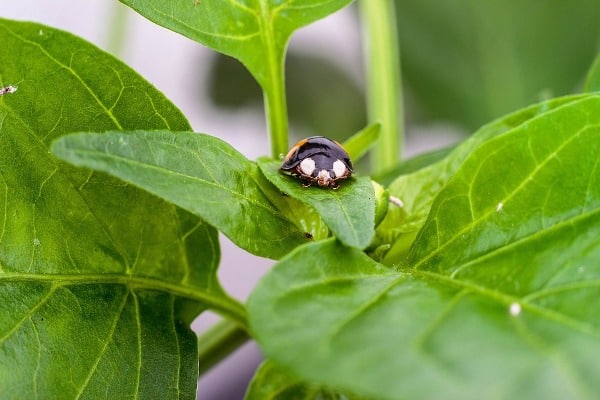
- Common pests that attack capsicum plants are aphids and spider mites.
- Aphids trouble the plant a lot, use natural remedies or organic pesticides to control aphids.
- Common pests can also be flushed with a strong spray of water mixed with mild soap or can be manually removed. Use only the mildest soap water, strong soaps can spoil the leaves.
- Plants should be taken a special in hot weathers from aphids and spider mites.
- Cutworms and Whiteflies also attack capsicum plants you can treat by using neem oil or horticultural spray.
- Capsicum plants are susceptible to diseases like bacterial wilt, powdery mildew, and root rots.
Harvesting in Growing Capsicum In Containers
- the Harvesting period for capsicum is 60 to 90 days.
- Harvest the green capsicum when they grow the full size and look firm.
- If they left to ripen, they turn yellow, orange, or red.
- Growth of new fruits stops when capsicum, starts ripening and changes to red color. So pick green-colored fruits in the early season and leave them to ripen towards the summer season.
- Use a sharp knife or scissors to harvest the capsicum very carefully.
- Capsicum is stored in plastic covers and placed in the refrigerator. they stay fresh for 10-15 days.
Tips for Growing Capsicum In Containers
Read this: Growing Lemons In Containers.
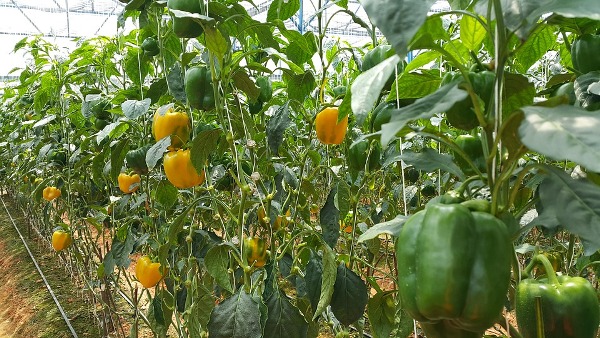
- Growing capsicum in extremely moist soil may cause seedlings to damp off and reduce the chances of germination.
- Early flowering can damage the growth of the plant. Once plants start flowering, plants put energy into growing fruits and fruits, then the growth of the young stems and foliage. So, deadhead the early flowers.
- Fruit formations can also be stopped, to speed up the maturity of the formed fruits.
- More pinching produces more fruits on the plant.
- The best time to sow seeds is 6-10 weeks before the last frost.
- In tropical regions, capsicum is grown round the year in containers.
- Basil and tomato are good companion plants for capsicum.
- The airing cupboard is the best place for seeds to germinate. During germination cover, the pots or seedling trays with plastic covers reduce the evaporation of water.
- Capsicum is easy to grow, just water them once or twice a week during hot summer and dry weather.
- Give them balanced fertilizer every three to four weeks.
- Capsicum seeds won’t germinate if you don’t provide them enough temperature.
- When plants turn sickly or frail, it indicates the nutrient imbalance in the soil.
- Protect your plant from temperature swings, cover them up with a hot cap or clear plastic container over the container.
- A good place for your container is near a south-facing wall, somewhere away from the winds.
- If growing in a large container, you can grow 2 to 3 plants.
In case if you are interested in this: How To Grow Organic Lettuce.
- Economical Aquaculture: A Guide to Low-Budget Fish Farming
- 15 Common Planting Errors That Can Doom Your Fruit Trees
- How to Make Houseplants Bushy: Effective Tips and Ideas
- Innovative Strategies for Boosting Coconut Pollination and Yield
- Pollination Strategies for Maximum Pumpkin Yield
- The Complete Guide to Chicken Fattening: Strategies for Maximum Growth
- Natural Solutions for Tulip Problems: 100% Effective Remedies for Leaf and Bulb-Related Issues
- Revolutionizing Citrus Preservation: Towards a Healthier, Greener Future
- Natural Solutions for Peony Leaf and Flower Problems: 100% Effective Remedies
- Maximizing Profits with Avocado Contract Farming in India: A Comprehensive Guide
- Natural Solutions for Hydrangea Problems: 100% Effective Remedies for Leaf and Flowers
- The Ultimate Guide to Choosing the Perfect Foliage Friend: Bringing Life Indoors
- From Sunlight to Sustainability: 15 Ways to Use Solar Technology in Agriculture
- The Ultimate Guide to Dong Tao Chicken: Exploring from History to Raising
- The Eco-Friendly Makeover: How to Convert Your Unused Swimming Pool into a Fish Pond
- Mastering the Art of Delaware Chicken Farming: Essentials for Healthy Backyard Flocks
- 20 Best Homemade Fertilizers for Money Plant: DIY Recipes and Application Methods
- How to Craft a Comprehensive Free-Range Chicken Farming Business Plan
- Brighten Your Flock: Raising Easter Egger Chickens for Beauty and Bounty
- How to Optimize Your Poultry Egg Farm Business Plan with These Strategies
- Subsidy for Spirulina Cultivation: How Indian Government Schemes Encouraging Spirulina Farmers
- Ultimate Guide to Raising Dominique Chickens: Breeding, Feeding, Egg-Production, and Care
- Mastering the Art of Raising Jersey Giant Chickens: Care, Feeding, and More
- Ultimate Guide to Raising Legbar Chickens: Breeding, Farming Practices, Diet, Egg-Production
- How to Raise Welsummer Chickens: A Comprehensive Guide for Beginners
- How to Protect Indoor Plants in Winter: A Comprehensive Guide
- Ultimate Guide to Grow Bag Gardening: Tips, Tricks, and Planting Ideas for Urban Gardeners